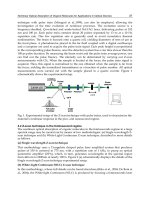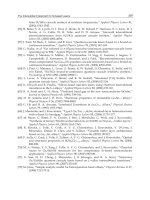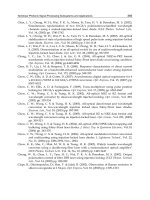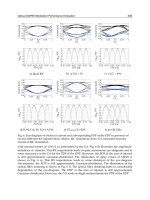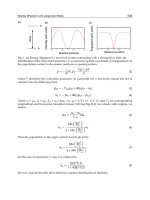Advances in optical and photonic devices Part 19 pdf
Bạn đang xem bản rút gọn của tài liệu. Xem và tải ngay bản đầy đủ của tài liệu tại đây (159.85 KB, 4 trang )
Ultra-Sensitive Optical Atomic Magnetometers and Their Applications
349
cost of conventional MRI machines. Such scanners can lead to wider spread of MRI
diagnostics around the world. Normally in NMR/MRI simple pick-up coils are used, but
the coils, which output signal according to Faraday’s law is the time derivative of the
magnetic flux, loose sensitivity at low frequency and do not perform well in the ULF regime.
Apart from this, the polarization of NMR and MRI spins is also weak in this regime. On the
other hand the standards of MR imaging are set very high with resolution on the order of 1
mm and SNR on the order of 30, setting demands on the sensitivity.
To enhance a weak NMR signal in the ULF regime, the method of prepolarization was
proposed (Macovski & Conolly, 1993). In this method, relatively large field (whichever is
practical to generate with a coil) is applied to polarize protons or other nuclear spins and is
turned off during the NMR/MRI measurements. The process is repeated many times. With
prepolarization method, the NMR signal is enhanced more than 1000 times compared to
that would be generated in microTesla fields at which MRI enconding and readout are
actually carried out. One advantage of the ULF readout and encoding is that gradients
arising from the ULF coil are quite small and no shimming is necessary. Still even with
prepolarization enhancement the SNR and resolution are quite inediquate if simple pick-up
coils are used at low frequency, and some solution of this problem is necessary. One
solution is to replace the coil with SQUIDs or AMs to achive additional gain in sensitivity.
ULF MRI with SQUIDs is now a conventional way to do ULF MRI. For example, recently an
airport security scanner have been built and tested based on a multi-channel SQUID
detector. However, in all low-Tc SQUID applications the main drawback the requirement
for cryogenics exists. The alternative solution to avoid cryogenics can be an atomic
magnetometer.
The most potentially useful AM magnetometer for MRI applications (Savukov et al., 2007) is
the high-density rf atomic magnetometer (Savukov et al., 2005) discussed in this chapter
which not only has very high sensitivity (fundamental limit about 0.1 fT/Hz
1/2
for 1 cm
3
cell
and practical noise was demonstrated 0.2 fT/Hz
1/2
) but also has sufficient bandwidth, on
the order of 1 kHz which is needed in MRI detection. The minimum bandwidth for efficient
scanner is estimated as the product of tissue relaxation rate and the number of pixels in
readout direction.
The demonstration of MRI with AM suitable for in situ imaging is the important step in the
direction of developing non-cryogenic ULF-MRI system, which was done in Ref. (Savukov
et al., 2009). The achieved sensitivity was on the order of 10 fT/Hz
1/2
, but further significant
improvement of the sensitivity is possible. Even without much modification of the system
with which the demonstration was done the sensitivity on the order of 1 fT/Hz
1/2
can be
achieved just by raising frequency from 3 kHz to 30 kHz, and with ultimate optimization the
sensitivity limits on the order of 0.1 fT/Hz
1/2
are possible, which would make the MRI
system suitable for clinical applications. This can be inferred from the scaling arguments
given in Ref. (Savukov et al., 2009).
- Other potential applications based on similar sensitivity as low-Tc SQUIDs
There are many other potential application of AMs which can be developed following
pioneering work on low-Tc SQUID applications. In biomedical imaging AMs can be applied
to multi-channel MCG imaging. Since heart anomalies are among leading causes of death,
their diagnostic is extremely important, and AM MCG can become a invaluable tool for
Advances in Optical and Photonic Devices
350
saving millions of lives. Multi-channel MCG provides reach information on electrical
activities in the heart non-invasively, and hence this modality can be crucial for revealing
heart anomalies and the analysis of their localization. In addition to biomedical applications,
AMs can be also used in submarine detection, geology, archeology, military applications,
and many other fields as we have already discussed in the introduction. However,
currently, high-sensitivity AMs are not available commercially, and this is the main
impediment for applications. We expect that in the near future the situation will
dramatically change, so all these applications will receive a significant boost.
6. Conclusion
We have considered the most sensitive atomic magnetometers based on high-density alkali-
metal vapors. This chapter covered the principles of the operation of ultra-sensitive
magnetometers and their applications. Among applications MEG and ULF MRI have been
considered in some detail. Because low-T
c
SQIUDs have been known as the most sensitive
magnetometers for a long time and are still considered such by many researchers, the
important conclusion from this chapter should be that atomic magnetometers can provide
similar sensitivity and can be used instead of SQUIDs in their applications.
7. Literature
Allred, J.; Lyman, R.; Kornack, T. & Romalis, M. (2002). A high-sensitivity atomic
magnetometer unaffected by spin-exchange relaxation. Phys. Rev. Lett. vol. 89,
130801.
Appelt, S.; Ben-Amar Baranga, A.; C. J. Erickson, C. J.; Romalis, M. V.; Young, A. R. &
Happer, W. (1998). Theory of spin-exchange optical pumping of
3
He and
129
Xe.
Phys. Rev. A vol. 58, p. 1412.
Appelt, S.; Ben-Amar Baranga, A.; Young, A. R. & Happer, W. (1999). Light narrowing of
rubidium magnetic-resonance lines in high-pressure optical-pumping cells. Phys.
Rev. A vol. 59, pp. 2078 – 2084.
Bell, W. E. & Bloom, A. L. (1957). Phys. Rev. Vol. 107, p. 1559.
Bloom, A. L. (1962). Principles of Operation of the Rubidium Vapor Magnetometers. Appl.
Optics Vol. 1, pp. 61-68.
Budker, D.; Kimball, D. F. & D. P. DeMille, D. P. (2004). Atomic physics, an exploration
through problems and solutions. Oxford Univ. Press.
Clarke, J. &Braginski, A. I. (Eds.) (2006). The SQUID Handbook. Wiley-VCH.
Cohen, D. (1972). Magnetoencephalography: detection of the brain’s electrical activity with a
superconducting magnetometer. Science vol. 175, pp. 664-666.
Cohen, D. (1968). Magnetoecephalography: evidence of magnetic field produced by alpha-
rhythm current. Science vol. 161, pp. 784-786.
Dehmelt, H. G. (1957). Phys. Rev. Vol. 105, p. 1487, 1924.
Happer, W. (1972). Optical Pumping. Rev. Mod. Phys. Vol. 44, pp. 169-250.
Groeger, S.; Pazgalev, A. S. & Weis, A. (2005). Comparison of discharge lamp and laser
pumped cesium magnetometers. Appl Phy. B Vol. 80, pp. 645-654.
Ultra-Sensitive Optical Atomic Magnetometers and Their Applications
351
Knappe, S.; Schwindt, P. D. D.; Gerginov, V., Shah, V.; Liew, L.; Moreland, J.; Robinson, H.
G.; Hollberg, L. & Kitching, J. (2006). Microfabricated atomic clocks and
magnetometers. J. Opt. A: pure Appl. Opt. pp. S318-S322.
Kornack, T. W. & Romalis, M. V. (2002). Dynamics of Two Overlapping Spin Ensembles
Interacting by Spin Exchange. Phys. Rev. Lett. Vol. 89, p. 253002.
Ledbetter, M. P.; Savukov, I. M.; Acosta, V. M. & Budker, D. (2008a) Spin-exchange
relaxation free magnetometry with Cs vapor. Phys. Rev. A vol. 77, p. 033408.
Ledbetter, M. P.; Savukov, I. M.; Budker, D.; Shah, V.; Knappe, S; J. Kitching, J.; Michalak,
D. J.; Xu, S. & Pines, A. (2008b). Zero-field remote detection of NMR with a
microfabricated atomic magnetometer. Proc. Natl. Acad. Sci. USA vol. 105, p. 2286.
Khriplovich, I. B. & Lamoreaux, S. K. (1997). CP Violation Without Strangeness: Electric
Dipole Moments of Particles, Atoms, and Molecules. Springer-Verlag.
Kominis, I. K.; T. W. Kornack, T. W.; Allred, J. C.& Romalis, M. V. (2003). A subfemtotesla
multichannel atomic magnetometer. Nature vol. 422, p. 596.
Macovski, A. & Conolly, S. (1993). Novel approaches to low-cost MRI. Magn. Reson. Med.
Vol. 40, pp. 221-230.
McDermott, R.; Trabesinger, A. H.; Mück, M.; Hahn, E. L.; Pines, A. & Clarke, J. (2002).
Liquid-State NMR and Scalar Couplings in Microtesla Magnetic Fields. Science
vol. 295, pp. 2247-2249.
Savukov, I. M. & Romalis, M. V. (2005). Effects of spin-exchange collisions in a high-
density alkali-metal vapor in low magnetic fields. Phys. Rev. A vol. 71, p. 023405.
Savukov, I. M. & Romalis, M. V. (2005). NMR detection with an atomic magnetometer.
Phys. Rev. Lett. vol. 94, p. 123001.
Savukov, I. M.; Seltzer, S. J.; Romalis, M. V. & and Sauer, K. L. (2005). Tunable Atomic
Magnetometer for Detection of Radio-Frequency Magnetic Fields. Phys. Rev. Lett.
vol. 95, 063004.
Savukov, I. M.; Seltzer, S. J. & Romalis, M. V. (2007). Detection of NMR signals with a
radio-frequency atomic magnetometer. JMR Vol. 185, p. 214.
Savukov, I. M.; Zotev, V. S.; Volegov, P. L.; Espy, M. A.; Matlashov, A. N.; Gomez, J. J.; &
Kraus, R. H., Jr. (2009). MRI with an atomic magnetometer suitable for practical
imaging applications. JMR 199, pp. 188-191.
Shah, V.; Knappe, S.; Schwindt, P. D. D. & J. Kitching, J. (2007). Nat. Photonics vol. 1, p. 649.
Seltzer, S. J. & Romalis, M. V. (2004). Unshielded three-axis vector operation of a spin-
exchange-relaxation-free atomic magnetometer." Appl. Phys. Lett. Vol. 85(20), p.
4804.
Smullin, S. J.; Savukov, I. M.; Vasilakis, G.; Ghosh, R. K. & Romalis, M. V. (2009). A Low-
Noise High-Density Alkali Metal Scalar Magnetometer. Archives: physics/0611085,
accepted to publication to PRA.
Volegov, P.; Matlachov, A., Mosher, J., Espy, M. A. & Kraus, R. H., Jr. (2004). Noise-free
magnetoencephalography recordings of brain function. Phys. Med. Biol. Vol. 49, pp.
2117-2128.
Wikswo, J. P. (2004). SQUIDs Remain Best Tools for Measuring Brain’s Magnetic Field.
Phys. Today Vol. 57, pp. 15-17.
Advances in Optical and Photonic Devices
352
Xia, H.; Ben-Amar Baranga, A.; Hoffman, D. & Romalis, M. V. (2006).
Magnetoencephalography with an atomic magnetometer. Appl. Phys. Lett. vol. 89,
p. 211104.
Zotev, V. S.; Matlashov, A. N.; Volegov, P. L.; Savukov, I. M.; Espy, M. A.; Mosher, J. C.;
Gomez, J. J. & Kraus, R. H., Jr. (2008). Microtesla MRI of the human brain
combined with MEG. JMR Vol. 194, pp. 115-120.
